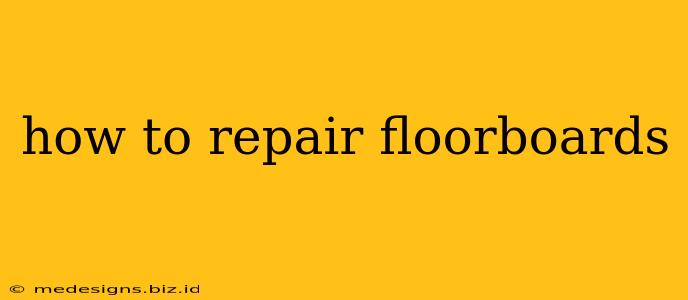Are your floorboards creaking, squeaking, or showing signs of wear and tear? Don't despair! Repairing floorboards is a manageable DIY project that can significantly improve the look and feel of your home. This comprehensive guide will walk you through the process, from identifying the problem to achieving a professional finish.
Identifying the Problem: What's Wrong with Your Floorboards?
Before you grab your tools, it's crucial to diagnose the issue. Different problems require different solutions. Common floorboard problems include:
- Squeaking: This often indicates loose floorboards rubbing against joists or each other.
- Creaking: Similar to squeaking, this usually means loose boards needing attention.
- Gaps: These can be caused by shrinkage, movement, or damage.
- Damage: This ranges from minor scratches and dents to significant rot or water damage.
- Unevenness: Some boards might be higher or lower than others, causing tripping hazards.
Tools and Materials You'll Need:
The specific tools and materials will depend on the type of repair, but generally, you'll need:
- Hammer: For driving nails and securing boards.
- Screwdriver: For removing and installing screws.
- Chisel: For prying up boards carefully.
- Wood filler: To repair small holes and gaps.
- Sandpaper: To smooth surfaces after filling.
- Putty knife: For applying wood filler neatly.
- Clamps: To hold boards in place while the glue dries.
- Wood glue: For securing loose boards.
- Nails or screws: To fasten boards securely.
- Safety glasses: To protect your eyes.
- Knee pads: To protect your knees.
- Measuring tape: To accurately measure gaps and boards.
- Optional: Floorboard repair kit: These kits often contain various tools and materials.
Step-by-Step Floorboard Repair Guide:
1. Assessing the Damage: Carefully examine the affected floorboards. Identify the extent of the damage and determine the best course of action.
2. Preparing the Area: Clear the area around the damaged floorboards. Protect surrounding areas with drop cloths.
3. Addressing Squeaking and Creaking:
- Locate the source: Carefully pinpoint the location of the squeaking or creaking.
- Lift the board (if necessary): Gently pry up the affected board using a chisel.
- Apply glue or shims: Apply wood glue to the underside of the board and/or insert shims to fill gaps.
- Re-secure the board: Carefully tap the board back into place using a hammer.
- Nail or screw: Secure the board with nails or screws.
4. Repairing Gaps:
- Clean the gap: Remove any debris from the gap.
- Apply wood filler: Use a putty knife to apply wood filler, ensuring it's level with the surrounding floorboards.
- Let it dry: Allow the filler to dry completely according to the manufacturer's instructions.
- Sand smooth: Once dry, sand the filler smooth using sandpaper.
5. Fixing Damaged Floorboards:
- Minor damage: Use wood filler to repair minor scratches and dents.
- Significant damage: Replacing damaged sections might be necessary. This often involves carefully removing the damaged section and installing a replacement piece.
6. Addressing Unevenness:
- Shim higher sections: Use thin shims to raise lower sections to match the surrounding floorboards.
- Sand down higher sections: If necessary, sand down higher sections to create a level surface.
Finishing Touches:
Once all repairs are complete, sand the entire area to ensure a smooth finish. You can then apply a suitable floor finish, such as varnish or paint, to protect the floorboards and enhance their appearance.
Preventing Future Floorboard Problems:
- Regular cleaning: Keep your floorboards clean to prevent dirt and debris from accumulating.
- Proper humidity control: Maintain a consistent level of humidity in your home to prevent expansion and contraction of the wood.
- Use floor protectors: Place rugs or mats in high-traffic areas to minimize wear and tear.
- Address water spills immediately: Quickly wipe up any spills to prevent water damage.
By following these steps, you can successfully repair your floorboards and restore their beauty and functionality. Remember, safety first! If you're unsure about any aspect of the repair process, it's always best to consult a professional.
